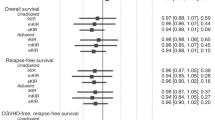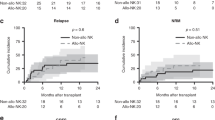Abstract
Achievement of complete donor chimerism (CDC) after allogeneic nonmyeloablative hematopoietic stem cell transplantation (NMHSCT) is important for preventing graft rejection and for generating a graft-vs-malignancy effect. The alloreactivity of NK cells and some T-cell subsets is mediated through the interaction of their killer immunoglobulin-like receptors (KIRs) with target cell HLA/KIR ligands. The influence of KIR matching on the achievement of T-cell CDC after NMHSCT has not been previously described. We analyzed 31 patients undergoing T-cell replete related donor NMHSCT following fludarabine and 200 cGy TBI. Recipient inhibitory KIR genotype and donor HLA/KIR ligand matches were used to generate an inhibitory KIR score from 1 to 4 based upon the potential number of recipient inhibitory KIRs that could be engaged with donor HLA/KIR ligands. Patients with a score of 1 were less likely to achieve T-cell CDC (P=0.016) and more likely to develop graft rejection (P=0.011) than those with scores greater than 1. Thus, patients with lower inhibitory KIR scores may have more active anti-donor immune effector cells that may reduce donor chimerism. Conversely, patients with greater inhibitory KIR scores may have less active NK cell and T-cell populations, which may make them more likely to achieve CDC.
This is a preview of subscription content, access via your institution
Access options
Subscribe to this journal
Receive 12 print issues and online access
$259.00 per year
only $21.58 per issue
Buy this article
- Purchase on Springer Link
- Instant access to full article PDF
Prices may be subject to local taxes which are calculated during checkout


Similar content being viewed by others
References
Niederwieser D, Maris M, Shizuru J, Petersdorf E, Hegenbart U, Sandmaier BM et al. Low-dose total body irradiation (TBI) and fludarabine followed by hematopoietic cell transplantation (HCT) from HLA-matched or mismatched unrelated donors and postgrafting immunosuppression with cyclosporine and mycophenolate mofetil (MMF) can induce durable complete chimerism and sustained remissions in patients with hematological diseases. Blood 2003; 101: 1620–1629.
Slavin S, Nagler A, Naparstek E, Kapelushnik Y, Aker M, Cividalli G et al. Nonmyeloablative stem cell transplantation and cell therapy as an alternative to conventional bone marrow transplantation with lethal cytoreduction for the treatment of malignant and nonmalignant hematologic diseases. Blood 1998; 91: 756–763.
Childs R, Clave E, Contentin N, Jayasekera D, Hensel N, Leitman S et al. Engraftment kinetics after nonmyeloablative allogeneic peripheral blood stem cell transplantation: full donor T-cell chimerism precedes alloimmune responses. Blood 1999; 94: 3234–3241.
Giralt S, Thall PF, Khouri I, Wang X, Braunschweig I, Ippolitti C et al. Melphalan and purine analog-containing preparative regimens: reduced-intensity conditioning for patients with hematologic malignancies undergoing allogeneic progenitor cell transplantation. Blood 2001; 97: 631–637.
McSweeney PA, Niederwieser D, Shizuru JA, Sandmaier BM, Molina AJ, Maloney DG et al. Hematopoietic cell transplantation in older patients with hematologic malignancies: replacing high-dose cytotoxic therapy with graft-versus-tumor effects. Blood 2001; 97: 3390–3400.
Antin J, Childs R, Filipovich AH, Giralt S, Mackinnon S, Spitzer T et al. Establishment of complete and mixed donor chimerism after allogeneic lymphohematopoietic transplantation: recommendations from a workshop at the 2001 Tandem Meetings. Biol Blood Marrow Transplant 2001; 7: 473–485.
Molldrem JJ, Lee PP, Wang C, Felio K, Kantarjian HM, Champlin RE et al. Evidence that specific T lymphocytes may participate in the elimination of chronic myelogenous leukemia. Nat Med 2000; 6: 1018–1023.
Hercend T, Takvorian T, Nowill A, Tantravahi R, Moingeon P, Anderson KC et al. Characterization of natural killer cells with antileukemia activity following allogeneic bone marrow transplantation. Blood 1986; 67: 722–728.
Ruggeri L, Capanni M, Urbani E, Perruccio K, Shlomchik WD, Tosti A et al. Effectiveness of donor natural killer cell alloreactivity in mismatched hematopoietic transplants. Science 2002; 295: 2097–2100.
Farag S, Fehniger T, Ruggeri L, Velardi A, Caligiuri MA . Natural killer cell receptors: new biology and insights into the graft-versus-leukemia effect. Blood 2002; 100: 1935–1947.
Lanier LL, Corliss BC, Wu J, Leong C, Phillips JH . Immunoreceptor DAP12 bearing a tyrosine-based activation motif is involved in activating NK cells. Nature 1998; 391: 703–707.
Unkeless JC, Jin J . Inhibitory receptors, ITIM sequences and phosphatases. Curr Opin Immunol 1997; 9: 338–343.
Vales-Gomez M, Reyburn HT, Mandelboim M, Strominger JL . Kinetics of interaction of HLA-C ligands with natural killer cell inhibitory receptors. Immunity 1998; 9: 337–344.
Hsu KC, Dupont B . Natural killer cell receptors: regulating innate immune responses to hematologic malignancy. Semin Hematol 2005; 42: 91–103.
Boyington JC, Sun PD . A structural perspective on MHC class I recognition by killer immunoglobulin-like receptors. Mol Immunol 2002; 38: 1007–1021.
Gumperz JE, Litwin V, Phillips JH, Lanier LL, Parham P . The Bw4 public epitope of HLA-B molecules confers reactivity with natural killer cell clones that express NKB1, a putative HLA receptor. J Exp Med 1995; 181: 1133–1144.
Ruggeri L, Capanni M, Casucci M, Volpi I, Tosti A, Perruccio K et al. Role of natural killer cell alloreactivity in HLA-mismatched hematopoietic stem cell transplantation. Blood 1999; 94: 333–339.
Giebel S, Locatelli FW, Lamparelli T, Velardi A, Davies S, Frumento G et al. Survival advantage with KIR ligand incompatibility in hematopoietic stem cell transplantation from unrelated donors. Blood 2003; 102: 814–819.
Sobecks RM, Ball EJ, Maciejewski JP, Rybicki LA, Brown S, Kalaycio M et al. Survival of AML patients receiving HLA-matched sibling donor allogeneic bone marrow transplantation correlates with HLA-Cw ligand groups for killer immunoglobulin-like receptors. Bone Marrow Transplant 2007; 39: 417–424.
Cook MA, Milligan DW, Fegan CD, Darbyshire PJ, Mahendra P, Craddock CF et al. The impact of donor KIR and patient HLA-C genotypes on outcome following HLA-identical sibling hematopoietic stem cell transplantation for myeloid leukemia. Blood 2004; 103: 1521–1526.
Hsu KC, Keever-Taylor CA, Wilton A, Pinto C, Heller G, Arkun K et al. Improved outcome in HLA-identical sibling hematopoietic stem cell transplantation for acute myelogenous leukemia (AML) predicted by KIR and HLA genotypes. Blood 2005; 105: 4878–4884.
Paul P, Apgar J, Ball EJ . HLA-DRB1* intron-primed sequencing for haploid genotyping. Clin Chem 2003; 49: 692–694.
Paul P, Thomas D, Kawczak P, Good D, Cook DJ, Ball EJ . Resolution of cis-trans ambiguities between HLA-DRB1 alleles using single-strand conformation polymorphisms and sequencing. Tissue Antigens 2001; 57: 300–307.
Baron F, Baker J, Storb R, Gooley TA, Sandmaier BM, Maris MB et al. Kinetics of engraftment in patients with hematologic malignancies given allogeneic hematopoietic cell transplantation after nonmyeloablative conditioning. Blood 2004; 104: 2254–2262.
Carvallo C, Geller N, Kurlander R, Srinivasan R, Mena O, Igarashi T et al. Prior chemotherapy and allograft CD34+ dose impact donor engraftment following nonmyeloablative allogeneic stem cell transplantation in solid tumor patients. Blood 2004; 103: 1560–1563.
Valcarcel D, Martino R, Caballero D, Mateos MV, Pérez-Simón JA, Canals C et al. Chimerism analysis following allogeneic peripheral blood stem cell transplantation with reduced-intensity conditioning. Bone Marrow Transplant 2003; 31: 387–392.
Matthes-Martin S, Lion T, Haas OA, Frommlet F, Daxberger H, König M et al. Lineage-specific chimaerism after stem cell transplantation in children following reduced intensity conditioning: potential predictive value of NK cell chimaerism for late graft rejection. Leukemia 2003; 17: 1934–1942.
Leung W, Iyengar R, Triplett B, Turner V, Behm FG, Holladay MS et al. Comparison of killer Ig-like receptor genotyping and phenotyping for selection of allogeneic blood stem cell donors. J Immunol 2005; 174: 6540–6545.
Denis L, Gagne K, Gueglio B, Kerduduo N, Milpied N, Simon P et al. NK-KIR transcript kinetics correlate with acute graft-versus-host disease occurrence after allogeneic bone marrow transplantation. Hum Immunol 2005; 66: 447–459.
Leung W, Iyengar R, Turner V, Lang P, Bader P, Conn P et al. Determinants of antileukemia effects of allogeneic NK cells. J Immunol 2004; 172: 644–650.
Murphy WJ, Kumar V, Cope JC, Bennett M . An absence of T cells in murine bone marrow allografts leads to an increased susceptibility to rejection by natural killer cells and T cells. J Immunol 1990; 144: 3305–3311.
Murphy WJ, Kumar V, Bennett M . Acute rejection of murine bone marrow allografts by natural killer cells and T cells. Differences in kinetics and target antigens recognized. J Exp Med 1987; 166: 1499–1509.
Neipp M, Gammie JS, Exner BG, Li S, Chambers WH, Pham SM et al. A partial conditioning approach to achieve mixed chimerism in the rat: depletion of host natural killer cells significantly reduces the amount of total body irradiation engraftment. Transplantation 1999; 68: 369–378.
Hallemeier C, Girgis M, Blum W, Brown R, Khoury H, Goodnough LT et al. Outcomes of adults with acute myelogenous leukemia in remission given 550 cGy of single-exposure total body irradiation, cyclophosphamide, and unrelated donor bone marrow transplants. Biol Blood Marrow Transplant 2004; 10: 310–319.
Kahl C, Mielcarek M, Iwata M, Harkey MA, Storer B, Torok-Storb B . Radiation dose determines the degree of myeloid engraftment after nonmyeloablative stem cell transplantation. Biol Blood Marrow Transplant 2004; 10: 826–833.
Sobecks R, Theil K, Rybicki L, Macklis R, Pohlman B, Andresen S et al. Improved post-transplant outcomes in hematologic malignancy patients undergoing non-myeloablative hematopoietic stem cell transplant (NMHSCT) using a 400 cGy total body irradiation (TBI) dose with fludarabine. Blood 2005; 106: 1023a (abstract no. 3674).
Author information
Authors and Affiliations
Corresponding author
Rights and permissions
About this article
Cite this article
Sobecks, R., Ball, E., Askar, M. et al. Influence of killer immunoglobulin-like receptor/HLA ligand matching on achievement of T-cell complete donor chimerism in related donor nonmyeloablative allogeneic hematopoietic stem cell transplantation. Bone Marrow Transplant 41, 709–714 (2008). https://doi.org/10.1038/sj.bmt.1705954
Received:
Revised:
Accepted:
Published:
Issue Date:
DOI: https://doi.org/10.1038/sj.bmt.1705954
Keywords
This article is cited by
-
Leukemia relapse via genetic immune escape after allogeneic hematopoietic cell transplantation
Nature Communications (2023)
-
Risk factors for vancomycin-resistant enterococcus bacteremia and its influence on survival after allogeneic hematopoietic cell transplantation
Bone Marrow Transplantation (2014)
-
Mixed chimerism in SCT: conflict or peaceful coexistence?
Bone Marrow Transplantation (2008)
-
400 cGy TBI with fludarabine for reduced-intensity conditioning allogeneic hematopoietic stem cell transplantation
Bone Marrow Transplantation (2008)



